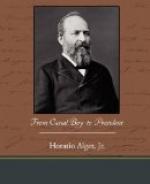“It happened that some of the humbler classes were among the most eager to signify their feelings. The omnibus-drivers had each a knot of crape on his whip. Many of the cabmen had the same thing, and so had the draymen. In the city, properly so called, and along the water-side, it was the poorer shops and the smaller craft that most frequently exhibited tokens of public grief. Of the people one met in mourning the same thing was true. Between mourning put on for the day and that which was worn for private affliction it was not possible to distinguish. But in many cases it was plain enough that the black coat on the workingman’s shoulders, or the bonnet or bit of crape which a shop-girl wore, was no part of their daily attire. They had done as much as they could to mark themselves as mourners for the President. It was not much, but it was enough. It had cost them some thought, a little pains, sometimes a little money, and they were people whose lives brought a burden to every hour, who had no superfluity of strength or means, and on whom even a slight effort imposed a distinct sacrifice. They are not of the class to whom the Queen’s command for Court mourning was addressed. Few of that class are now in London. St. James’ Street and Pall Mall, Belgravia and May Fair are depopulated. The compliance with the Queen’s behest has been, I am sure, general and hearty, but evidences of it were to be sought elsewhere than in London.
“Of other demonstrations it can hardly be necessary to repeat or enlarge upon the description you have already had. The drawn blinds of the Mansion House and of Buckingham Palace, the flags at half-mast in the Thames on ships of every nationality, the Stock and Metal Exchanges closed, the royal standard at half-mast on the steeple of the royal church of St. Martin-in-the-Fields; the darkened windows of great numbers of banking houses and other places of business in the city itself—of all these you have heard.
“At the West End, the shops were not, as a rule, draped with black. Some of them had the Union Jack at half-mast; a few the Stars and Stripes in black with white and black hangings on the shop fronts. The greater number of shop-keepers testified to their association with the general feeling by shutters overhanging the tops of the windows, or by perpendicular slabs at intervals down the glass. Some had nothing; but in Regent Street, Bond Street, St. James’ Street, and Piccadilly, which are the fashionable business streets of the West End, those which had nothing were the exception. The American Legation in Victoria Street, and the American Consulate in Old Broad Street, both of which were closed, were in deep mourning. The American Dispatch Agency, occupying part of a conspicuous building in Trafalgar Square, had nothing to indicate its connection with America or any share in the general sorrow.
“In many private houses—I should say the majority in such streets as I passed through during the day—the blinds were down as they would have been for a death in the family. The same is true of some of the clubs, and some of the hotels. The Reform Club, of which Garfield is said to have been an honorary member, had a draped American flag over the door.




